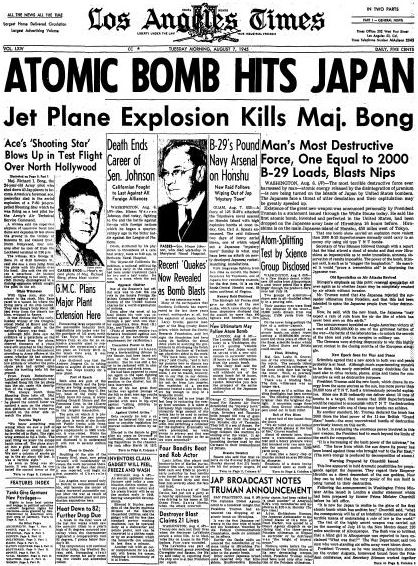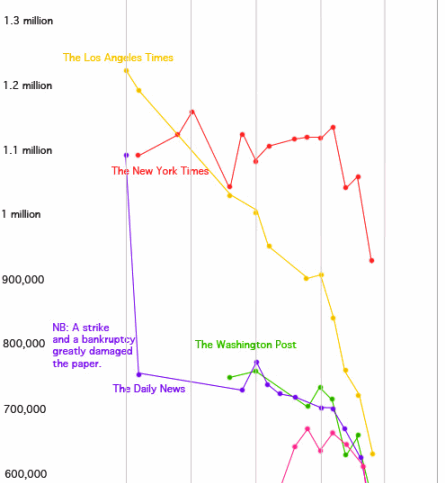L.A. Times Attempting Suicide
MARCH 5, 2012
By JOHN SEILER
Today the Los Angeles Times is charging for visiting its site online. This is a suicide attempt that will severely damage the paper. Its parent company, Tribune Co., long has been in bankruptcy, running up $233 million in legal fees.
According to the Times’ own story:
“The Los Angeles Times will begin charging readers for access to its online news, joining a growing roster of major news organizations looking for a way to offset declines in revenue.
“Starting March 5, online readers will be asked to buy a digital subscription at an initial rate of 99 cents for four weeks. Readers who do not subscribe will be able to read 15 stories in a 30-day period for free. There will be no digital access charge for subscribers of the printed newspaper….
“Other news outlets that have begun charging for online journalism include the New York Times, the Wall Street Journal and the Dallas Morning News. Gannett, the nation’s largest newspaper company, this week announced plans to launch a similar program at 80 publications, saying it could boost earnings by $100 million in 2013.”
They don’t get it. They still don’t get it.
Since 1994, when the first decent Web browser, Netscape, became available, the newspaper business model has been doomed. People now expect basic news to be free. They also don’t want to mess around with complicated log-ins and price plans for basic news.
Paid Sites
The Times cited The Wall Street Journal as making money on its paid site. They’re enticed by the subscription figures in the following graph, from The Awl. It shows newspaper circulation from 1990-2009. At the top is the success of the Journal.
The look at the yellow line, the L.A. Times, which has declined the fastest of all — a meteor downward. The circulation decline has continued, from about 625,000 in 2009 to 573,000 today.
The Journal’s model is succeeding because the Journal offers more than basic news: It offers specialty news, on finances. People will pay money to make money. The’ll also pay money for other specialty news, such as dating and game sites. That model also is working for the Financial Times, which specializes in international business news.
If you’re a bond trader making well into the six figures a year, paying for an FT or Journal subscription is chump change. It provides crucial information you use for your business. Those publications also provide large research files for checking out potential businesses to invest in. But that model doesn’t work for publications that provide news one can get elsewhere.
As to the New York Times, it lost $40 million last year. So why imitate their business model?
As to the Dallas Morning News, starting Feb. 15, it charged $33.95 a month for a subscription and full access to its online news. That’s $407.40 a year — in tough economic times. It’s obviously too early to tell if that’s going to work. But a newspaper that once was in the top 10 in circulation in the country now has dropped to 16th — even though Dallas and Texas have seen booming population in recent years.
According to the L.A. Times story, for LAT subscriptions:
“After the initial rate of 99 cents for the first four weeks, the rate will rise to $1.99 a week in a package that also includes the Sunday newspaper. Digital-only access will cost $3.99 a week.”
So, you pay half ($1.99) a week if you get the paper edition, which means they want the ads that pay for everything plopping on your doorstep every day. That’s $103.48 a year. But if you don’t the paper version — maybe the Times’ editorials have convinced you that killing all those trees adds to global warming — then you pay $3.99 a week, or $207.48 a year. It’s not going to work.
Two Problems
There are two problems with the Times. The first is that the newspaper industry continues to erode. This is unfortunate. I’ve been in the newspaper business for 27 years now, and I lament the passing of a great industry. I’ll always be a “newspaperman.” I still get home delivery of the daily printed Orange County Register, my old paper, and the Sunday Los Angeles Times. But that’s the reality.
I don’t know many people under 40 who subscribe to newspapers. This includes smart kids in graduate school. They do everything online.
The Times’ second problem is its grating liberalism. There’s seldom a vast new government program or gigantic tax increase that they don’t support. All of their five top columnists are obsessed with tax increases, as I have detailed on CalWatchDog.com.
And as my colleague Steven Greenhut wrote today, columnist Michael Hiltzik has defended the possibly criminal fraud eco-extremist Peter Gleick perpetrated against the Heartland Institute. Gleick himself has apologized. Yet Hiltzik wrote: “But it’s Heartland, which has tagged Gleick with the epithets above, that should be answering for its nearly three-decade history of corporate shilldom.”
So, Hiltzik says it’s OK for Gleick to perpetuate a fraud. And the Los Angeles Times employes Hiltzik. So why should I believe anything written in the Times?
As to Hiltzik’s charges against Heartland: It’s public knowledge where its funding comes from. And any think tank gets its money from sources favorable to its research. How does any of that justify fraud?
$$$$$$$$$$$$$$$$$$$$$$$$$$$$
It’s also a good question how much money the L.A.Times will derive from this. Its article on the switch to paid online membership explained:
“[Media analyst Edward] Atorino said the New York Times has not sold digital subscriptions at the rate he expected. Most of the subscriptions it sells are highly discounted, diminishing the revenue gain, he said. The company does not break out its revenue for digital subscriptions.”
So no one has any idea if the main non-financial newspaper that switched to digital subscriptions actually is making money from it!
The article continues, quoting Kathy Thomson, president and chief operating officer of Los Angeles Times Media Group.:
“The Times won two Pulitzer Prizes last year, including the gold medal for public service for its coverage of corruption in the city of Bell.
“‘People are going to want to read our award-winning journalism’, Thomson said.”
People don’t care about Pulitzers and other awards. Anyway, 99 percent of the awards go to liberals. And why did it take the Times so long to report on the Bell corruption, which was going on for decades? How hard would it have been to notice that City Manager Robert Rizzo raked in $787,637 a year in salary, with 12 percent annual increases, guaranteed?
The fact is that the Times has been missing stories for years.
And whenever it does break something, its articles quickly are cross-posted to other Web sites, including newspapers that carry the Times’ news service. So, in the end, there’s no need to pay for its stories.
A better model is that of the Orange County Register, which is building up strong online loyalty, for example for their reporting on the Angels baseball team, which has a nationwide following. If you go to that site, the ads are not just local, but national and for Southern California.
“Information wants to be free” is a slogan of techno-anarchists. The Times is going to find that out — the hard way.
Related Articles
California GOP Never Learns
John Seiler: California desperately needs a competitive second party to challenge the mega-majority Democrats. Too bad the main alternative is
Why do Dems nominate Pelosi, Feinstein, Boxer?
California is supposed to be a liberal state, with the most liberal Democratic Party in the country. Yet its top
Bernie Sanders’ CA return revisits Democrat divides
Underscoring lingering divides in a Democratic Party facing an uncertain future, Bernie Sanders returned to California in the campaign season’s final






